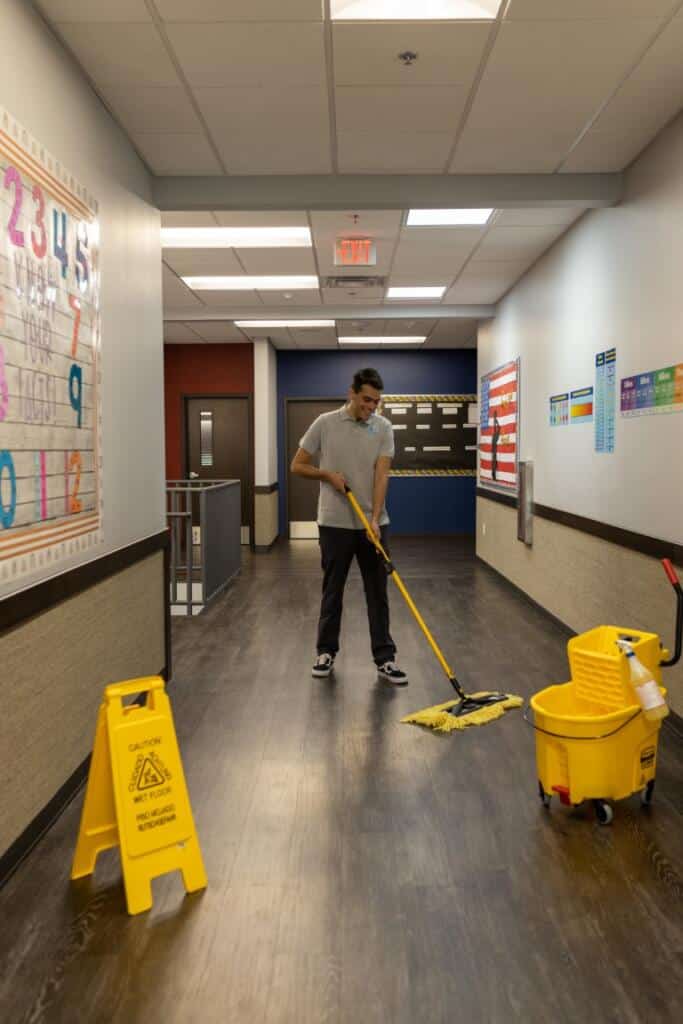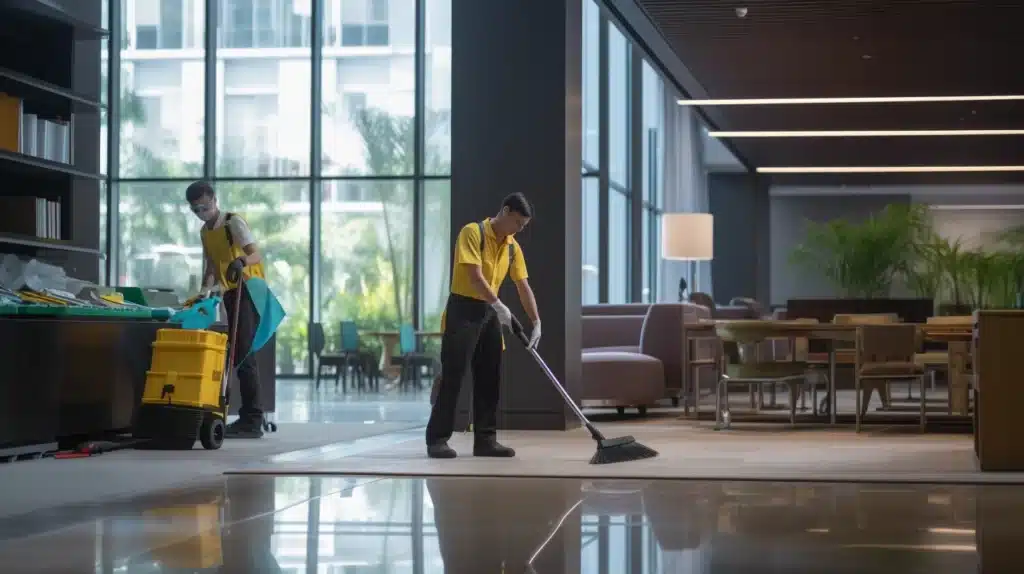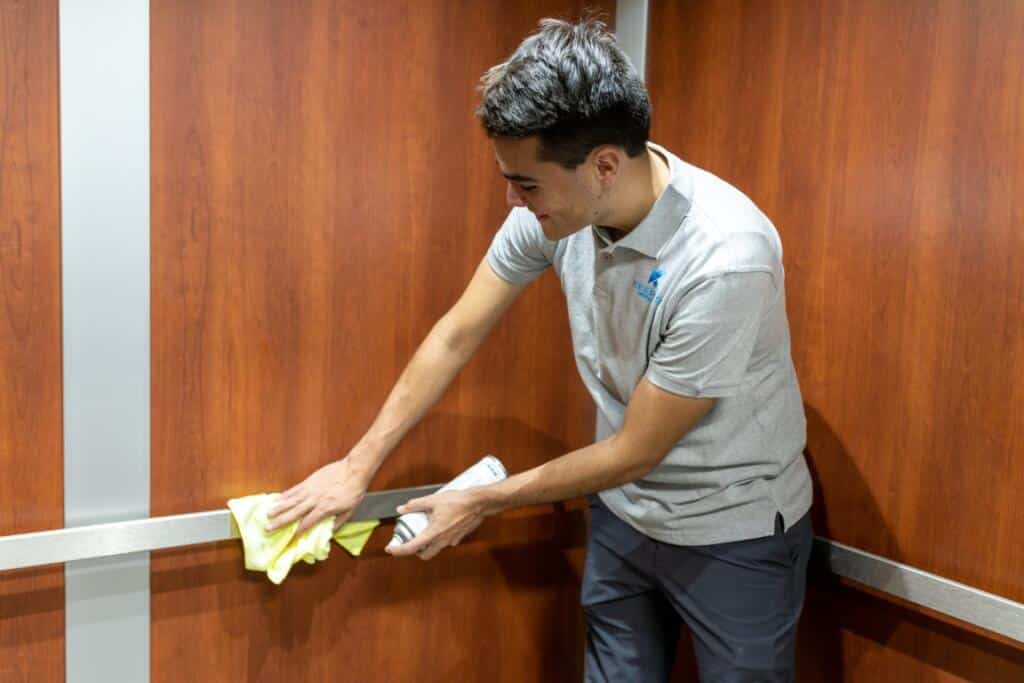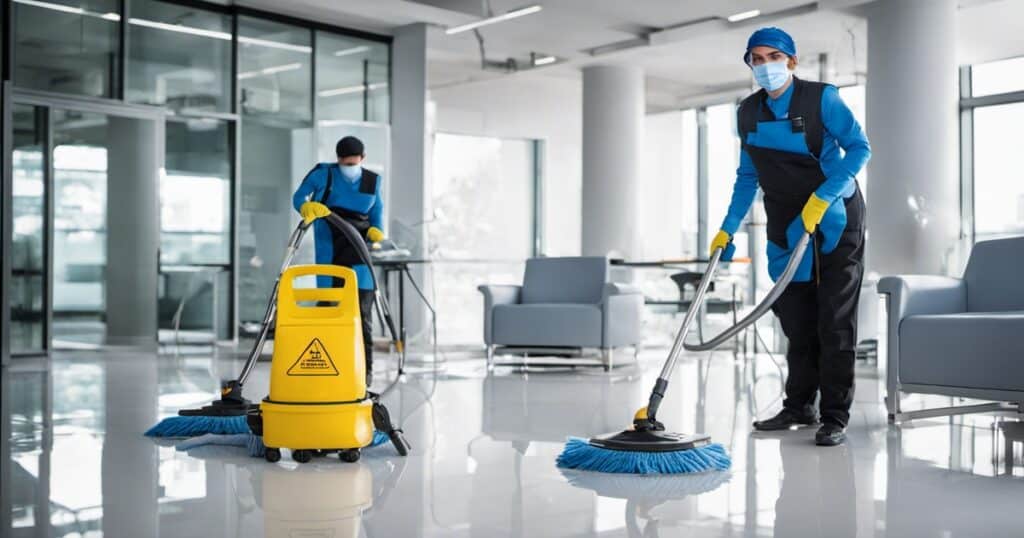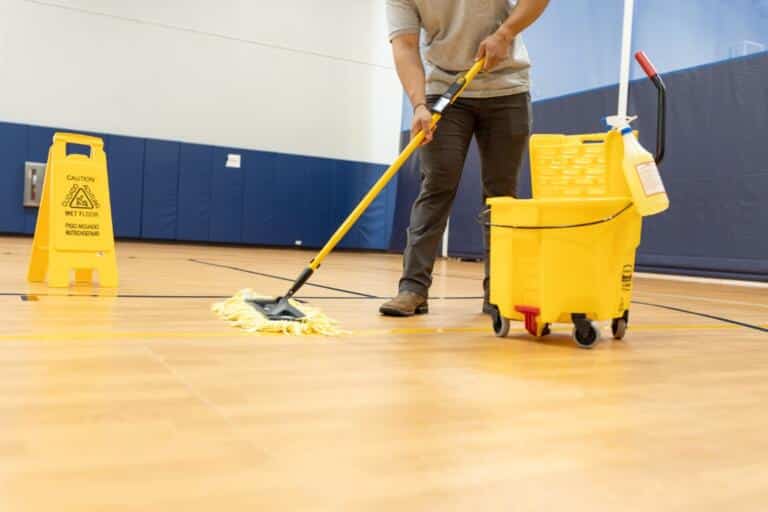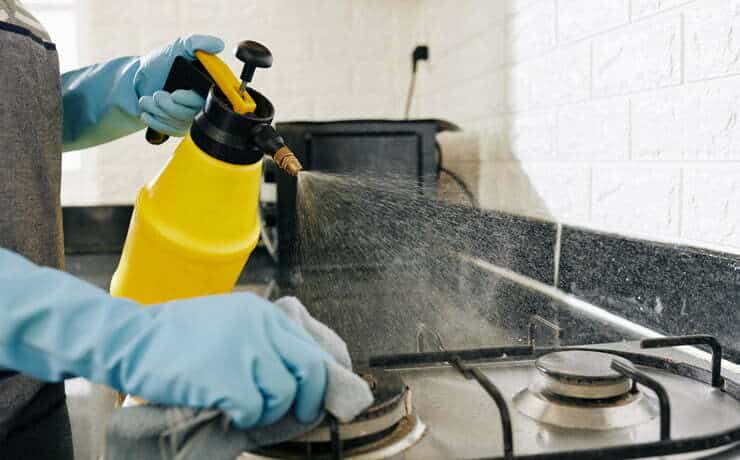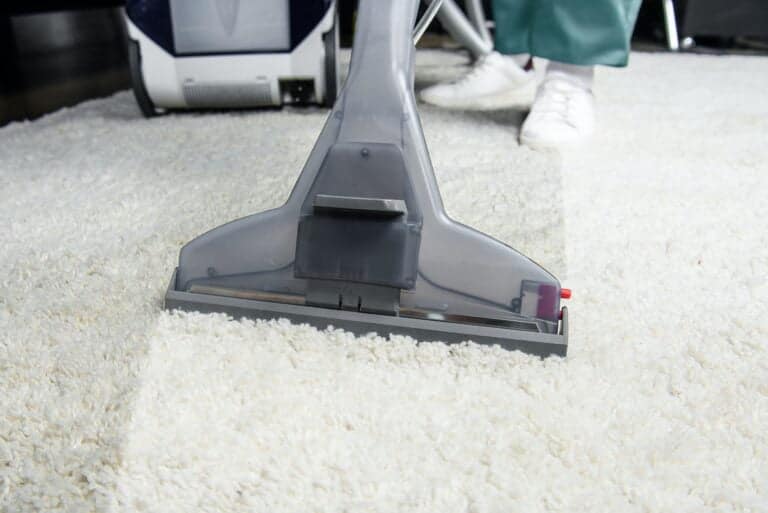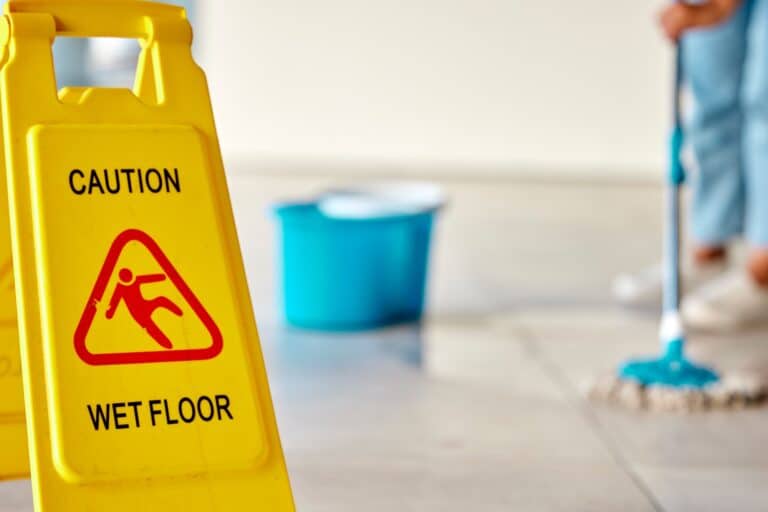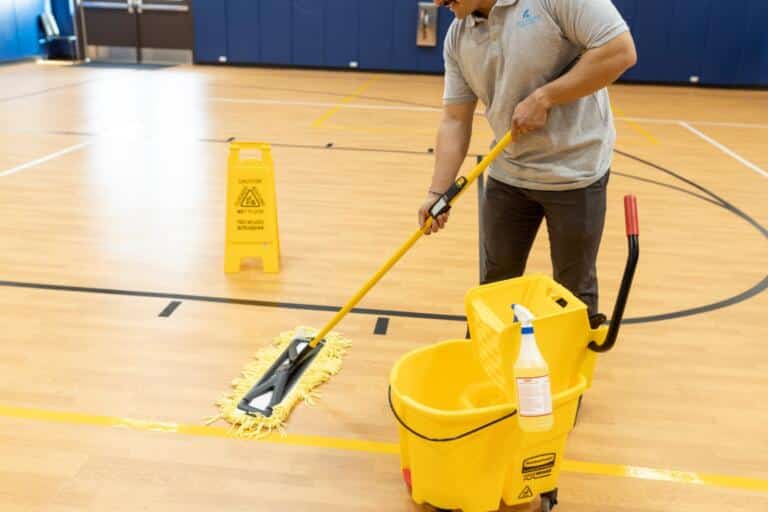Maintaining your copper range hood isn’t just about keeping it shiny; it’s a crucial step to ensure its longevity, optimal performance, and patina. Regularly changing air filters and addressing repairs are essential tasks for this kitchen product. Ever wonder how the hustle of your kitchen affects the patina on those stunning tiles above your cooktop, or how it impacts the integrity of the grout?
Consider using a durable product to maintain that pristine look. A well-kept copper hood with a developing patina doesn’t just do a better job at sucking up smoke and odors through its vents; it also retains its lustrous appeal, turning heads as the boss piece in your house for years. Whether you’re simmering sauces daily in your house or firing up the fan for weekend feasts, matching your cleaning routine to your culinary adventures is key, especially when maintaining the patina of your tiles and the cleanliness of your grout.
Related: The Benefits of Eco-Friendly Cleaning Products
Let’s dive into the nitty-gritty of keeping that copper range hood as striking and functional as the day you installed it, ensuring the grout between your kitchen tiles remains pristine, and your pattern of maintenance posts continues uninterrupted.
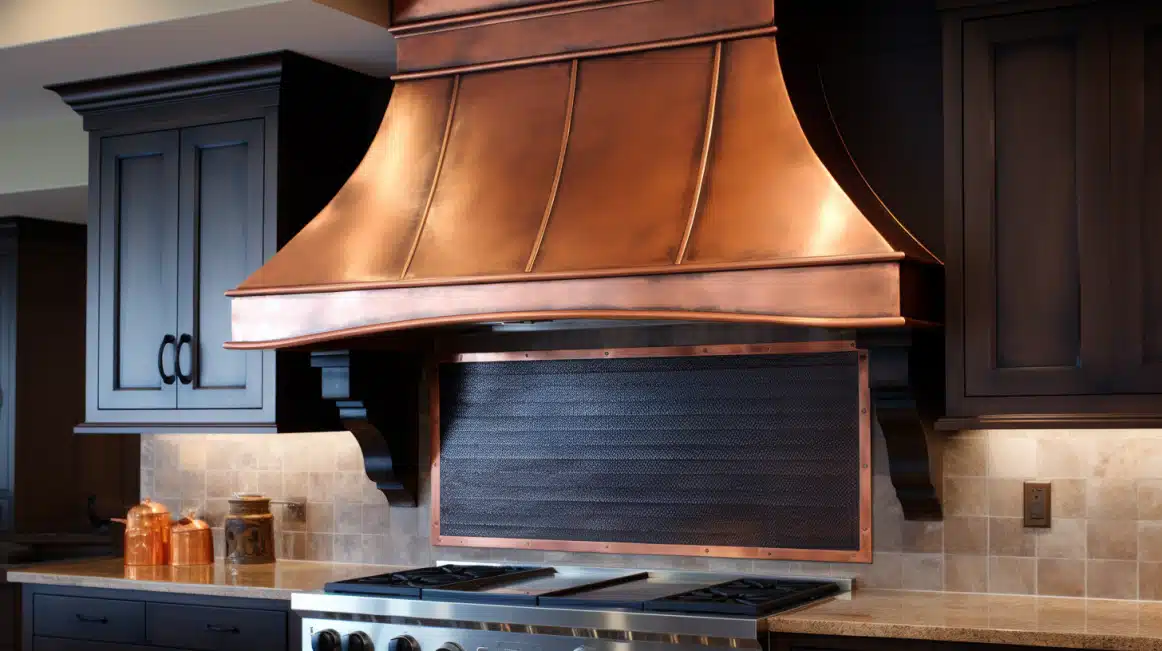
Detailed Cleaning Steps for a Copper Hood
Copper range hoods, like tiles in a kitchen, can become dull and accumulate grime within the pattern of grout lines over time, leading to visible cracks and dirt. Regular cleaning of tiles with the right materials keeps grout free from cracks and posts looking their best.
Basic Cleaning Method
Start with the simplest solution for cleaning tiles: mild soap and warm water. Regular maintenance can prevent cracks and keep your posts looking pristine. This combo works wonders on copper hoods without being harsh, preventing cracks and keeping your tiles looking pristine as highlighted in our latest posts.
- Mix a few drops of mild dish soap in a bucket of warm water to gently cleanse the cracks between tiles.
- Soak a soft cloth in the soapy water, wring it out well, and gently wipe over the tiles to clean away any dirt from the cracks.
Gently wipe down the hood to remove surface grime. This method is your go-to for routine maintenance.
Soft Cloth Application
Choosing the right tool for cleaning is key. When cleaning tiles, a soft cloth is your best friend to avoid scratches.
- Use a microfiber or other non-abrasive cloth.
- Always rub gently, especially on spots with more gunk.
The goal is to clean your tiles without leaving any battle scars on your hood!
Dry Immediately
Water spots can be an eyesore on copper. Drying immediately after washing keeps your hood spotless.
- Ensure you have a clean, dry towel ready before you begin washing your tiles.
- Pat down the hood tiles right after cleaning to soak up moisture.
This step ensures that water doesn’t linger long enough on the tiles to leave its mark.
Gentle Polishing Moves
Polishing tiles brings out the shine but requires a light touch. Use gentle circular motions during this stage.
- Apply a copper-friendly polish sparingly.
- With another soft cloth, buff in circular patterns for even sheen.
Think of it like waxing a car; slow and steady wins the race!
Avoid Harsh Chemicals
Some cleaners are too tough for copper’s delicate surface. Desert oasis cleaners might sound strong, but they’re not always suitable here.
- Steer clear of abrasive or acidic cleaning agents.
- Check labels—oasis cleaners should be pH-neutral and non-corrosive.
Remember,Gentle is better than aggressive!
Tackling Stubborn Dirt
Sometimes you encounter dirt that won’t budge easily. For these stubborn areas:
- Reapply soapy water and let it sit briefly.
- Gently scrub with the soft cloth in circular motions.
- Rinse off with more warm water and immediately dry with your towel.
Patience pays off when dealing with tough dirt patches without damaging your hood’s finish.
Related: Spring Cleaning: How to Reduce Allergens in Your Workplace
Removing Sticky Grease from Copper Hood
Sticky, stubborn grease on copper hoods can be a real headache. But with the right techniques and products, that gunk doesn’t stand a chance when you clean a copper range hood properly.
Vinegar Solution Magic
Got excessive grease? No worries. Vinegar’s your hero here. This wonder liquid is amazing for dissolving that greasy mess. Just mix it up with some water, and you’ve got yourself a powerful cleaner to clean your range hood.
- Start by mixing equal parts of vinegar and water.
- Dip a soft cloth into the solution.
- Gently wipe over the greasy areas.
- Watch as the grease starts to break down.
Vinegar’s acidity cuts through the grime like butter to clean a copper range hood. It’s natural, too, so no harsh chemicals around your food space.
Baking Soda Power
For those tough-as-nails spots, baking soda enters the ring. Make a paste, slap it on, and let it do its boxing match with grime.
- Mix baking soda with water until it forms a paste.
- Apply directly onto stubborn grease marks.
- Leave it for a few minutes to work its magic.
Baking soda is gritty enough to scrub but won’t scratch your precious copper hood. It’s like an eraser for dirt!
Commercial Degreaser Choice
Sometimes you gotta bring in the big guns—commercial degreasers designed for copper surfaces are just that. They’re formulated especially so they won’t tarnish or damage your hood while they obliterate grease.
- Choose a degreaser suitable for copper.
- Follow the instructions carefully—safety first!
These cleaners are strong but safe when used right. They can make quick work of even the most stubborn grease spots.
Immediate Wipe Down
The best defense is a good offense! Wiping off grease spills immediately can save you loads of trouble later on.
- Keep a cloth handy whenever cooking.
- Swiftly wipe any splatters or spills.
Quick action prevents buildup and makes deep cleaning sessions less frequent—and who doesn’t want that?
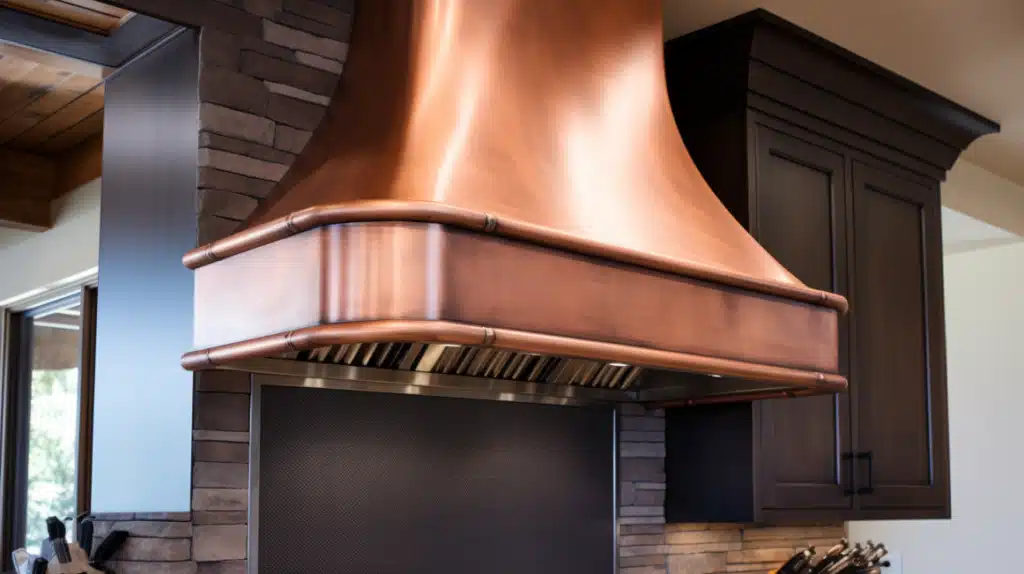
Maintaining the Exterior of Copper Hood
Keeping your copper hood in top shape involves regular dusting and careful cleaning. Protect it further with wax, and watch for changes in its patina.
Regular Dusting Routine
Kick off your maintenance with a soft cloth. Gently sweep away dust from your copper hood’s exterior surfaces to prevent grime accumulation. It’s like brushing your teeth; do it often to avoid bigger issues down the road.
Skip Harsh Chemicals
Harsh chemicals are the arch-enemy of copper hoods. They can cause more drama than a soap opera, tarnishing that beautiful surface quicker than you can say “oops.” Stick to mild soaps or specific copper cleaners recommended by the manufacturer.
Wax On for Protection
After cleaning, think of wax as your hood’s superhero cape. Apply a thin layer of quality wax designed for copper. This will shield your kitchen boss from splatters and stains.
- A good wax seals the deal.
- It makes future cleanups a breeze.
Monitor Patina Progress
Patina on copper isn’t just corrosion; it’s character. Like watching kids grow up, observing the patina develop over time can be fascinating. If you’re not into that aged look, though, keep an eye on it and know when to intervene with some gentle polishing.
- Patina adds unique beauty.
- Too much? Time for repairs!
Copper Range Hood Air Filter Cleaning
Before diving into the nitty-gritty of cleaning your range hood’s air filters, it’s crucial to identify whether you’re dealing with charcoal or metal types. Metal filters require a good soak in a degreaser, while charcoal ones have a set expiration date and need replacing, not washing.
Check Filter Type
First things first: know your filter. Your copper range hood could be sporting either a charcoal or metal air filter. This determines your next steps.
- Charcoal filters can’t take a bath; they’re one-and-done.
- Metal filters are ready for some spa time in degreaser.
Soak Metal Filters
Metal filters love a good soak. It’s like sending them on a mini-vacation where they come back rejuvenated and ready to work better than ever.
- Mix up that degreasing solution; let those filters chill in there.
- A simple dish soap and baking soda combo works wonders too.
Replace Charcoal Filters
Charcoal filters don’t last forever. They’ve got an “out with the old, in with the new” kind of vibe going on every few months or so.
- Keep track of their lifespan; mark your calendar for swap-out time.
- No cleaning shortcuts here—just replace when it’s time!
Dry Before Reinstalling
Rust is like that uninvited guest at parties—it just shows up if you don’t dry your metal filters properly before putting them back.
- Patience is key; let them air dry completely.
- A little sunbathing for the filters doesn’t hurt either (if it’s sunny out).
Selecting Suitable Ventilation for Copper Hood
Getting the right ventilation system for your copper range hood is crucial. You need to match the hood size with proper CFM and consider ductwork compatibility, noise levels, and energy efficiency.
Right Size, Right Power
Your copper range hood needs a vent that can handle the heat and smoke from your cooktop. The key is finding a balance between size and power. The ventilation system’s capacity is measured in cubic feet per minute (CFM). Here’s a simple rule:
- For every 100 BTU of your stove’s output, you need about 1 CFM of ventilation power.
So, if you’ve got a beast of a stove blasting out 40,000 BTUs, aim for a vent with at least 400 CFM. But don’t overdo it – too much power could be overkill and just waste energy.
Ductwork Compatibility Check
Before you go shopping for that shiny new vent, peek inside your kitchen’s guts – I’m talking about the ductwork. New vents gotta fit with what you’ve already got unless you’re up for some serious remodeling.
- Round ducts or rectangular?
- Existing duct size?
Make sure the new unit will play nice with these or get ready to call in the pros for an overhaul.
Noise Level Smarts
Ever tried having a convo while standing next to a launching rocket? Yeah, neither have I. But picking a vent without checking its noise level might just give you that experience.
You want something that won’t drown out your dinner party banter but still packs enough punch to clear out smoke from your searing steak masterpiece. Motor power matters here:
- Higher CFMs usually mean more noise.
- Look for units with sound-dampening tech.
This way, you keep both your ears and lungs happy.
Energy Efficiency Matters
We’re all about saving the planet one kilowatt at a time, right? So let’s talk about energy-efficient models:
- They save on utility bills.
- They often come with cool features like LED lights and auto shut-off.
Sure, they might cost more upfront but think long-term savings – both for your wallet and Mother Earth.
Essential Preventative Measures for Copper Hoods
Copper range hoods demand specific care to maintain their luster and function. Immediate action against spills and proper installation are key.
Avoid Acidic Spills
Acidic substances can be a nightmare for copper hoods. The moment you spot a spill, spring into action.
- Vinegar or tomato sauce splatters? Wipe them off pronto.
- Use a soft cloth and gentle cleaner to avoid scratches.
These quick responses prevent lasting stains that tarnish your hood’s reputation.
Shield From Flames
Direct flames are bad news for copper hoods. They can discolor the metal, leaving unsightly marks.
- Keep the flame under your pots, not licking the hood.
- Adjust your burners if they’re too close to the edge.
This way, smoke patterns won’t etch themselves onto your copper masterpiece.
Correct Installation Height
Installing your hood at the right height is crucial. It’s not just about aesthetics; it’s about performance and safety too.
- Follow the manufacturer’s guidelines to a T.
- Too low? You risk dents and excessive heat exposure.
Getting this right from day one saves you a headache down the line. No one wants a do-over because of poor planning!
Regular Inspection Routine
Set times to give your hood some TLC. A stitch in time saves nine, as they say.
- Check seams and joints every few months.
- Look out for loose parts or unusual wear patterns.
Staying on top of these checks keeps small issues from becoming big problems. And trust me, catching them early is always better than making an emergency call later!
Mastering Copper Range Hood Care
Alright, let’s wrap this up! You’ve got the inside scoop on keeping your copper range hood looking as sharp as a tack. From tackling that pesky grease to ensuring the air filter is breathing easy, you’re all set to make your kitchen centerpiece shine. Remember, it’s not just about making it sparkle; it’s about preserving that classic look for the long haul. And hey, don’t forget those preventative measures—we’re talking about avoiding harsh chemicals and rough scrubbers like they’re yesterday’s news.
So go ahead, give your copper hood the TLC it deserves. And if you ever hit a snag or need a hand figuring out what’s best for your kitchen swagger, don’t hesitate to reach out to a pro. They’ll steer you right and keep that hood looking like a million bucks. Now roll up those sleeves and show your range hood some love—it’ll pay off big time!
FAQs
What cleaning solutions are safe for my copper range hood?
For routine cleaning of your copper range hood, stick with gentle solutions such as warm water mixed with mild dish soap. If you need something stronger for occasional deeper cleanses, opt for specialized copper cleaners that are designed to be gentle on the metal while effectively removing tarnish and buildup.
How often should I clean my copper range hood?
Aim to wipe down your copper range hood weekly with a soft cloth and mild soapy water to prevent buildup of grease and grime. For more thorough cleanings or polishing, doing so every few months should keep it in top condition.
Can I use vinegar to clean my copper range hood?
While vinegar can be used occasionally for cleaning tough spots or tarnish on copper due to its acidic nature, frequent use is not recommended as it can lead to discoloration over time. It’s better to use products specifically formulated for copper care.
Is it necessary to polish my copper range hood?
Polishing is not strictly necessary but can help maintain the luster and appearance of your copper range hood if done sparingly with appropriate polishes designed for use on copper surfaces.
What should I avoid using on my copper range hood during cleaning?
Steer clear of abrasive sponges or scouring pads which can scratch the surface of your hood. Also avoid bleach-based cleaners or those containing chloride as they can damage the finish of the metal.
Does cooking style affect how I should maintain my copper range hood?
Yes! If you do a lot of high-heat cooking or frying, you may need to clean the exterior and filters of your range more frequently due to increased grease accumulation.
Can installing proper ventilation extend the life of my copper range hood?
Absolutely! Good ventilation helps reduce grease and moisture buildup which can corrode metal over time. Ensure that you have suitable ventilation in place not only for maintaining air quality but also for protecting your investment in a beautiful copper range hood.

